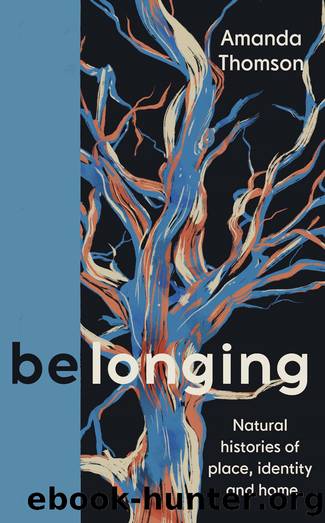Belonging: Understories of Nature, Family and Home by Amanda Thomson

Author:Amanda Thomson [Thomson, Amanda]
Language: eng
Format: epub
ISBN: 9781838854720
Google: HujrzgEACAAJ
Publisher: Canongate Books
Published: 2022-04-12T20:34:52+00:00
bone black
lamp black
brown black
carbon black
velvet black
vine black
soft black
blue black
And thatâs not an exhaustive list. Each will give a warmer or cooler tone that subtly alters how a print looks. Some are stickier and may work better on some plates than others. Bone Black, for example, seems to work really well on polymers, and generally is my favoured ink. And then there are the papers â like Somerset Satin, Somerset Velvet, Fabriano Artistico, Rives, Hahnemühle, Arches â which come in different weights and give whites of varying textures and tones, colder and warmer, that will shift the very atmosphere of the print.
The processes involved in etching, the repetitious difference involved in making each new plate, the return to the beginning, and the steps that must be taken in order to get to the point when the print can be pulled all require patience, but itâs rewarded in spades.
And then to the printing itself. First, Iâll select the paper, tear it down to the right size, if necessary, and soak it in a bath of water so that the fibres soften and it becomes more receptive to the ink when itâs run though the press. I ink the plate using a rubber squeegee, coating the whole plate in a thin layer, then use a dabber, a leather-covered pad with a handle, to press the ink into the plate and the lines that have been etched by the acid. Then I use scrim, a loosely woven, coarse cotton fabric, to remove most of the ink. I bunch the scrim into a flat, smooth pad and, using a circular motion, quite heavy-handedly at first, feel the resistance of the ink and its stickiness, then use it more gently as I reach the end of the process. Once the excess ink has been removed, Iâm left with the ink that sits on/in the image, that is to say, the ink that now remains in the etched lines.
Iâm nearly there, but last, I take the heel of my hand and lightly wipe the plate, which somehow just takes off the last of the excess ink, then I clean round the bevelled edges to remove any stray flecks.
And as I write this, months on since I last made a print, I can feel the muscle memory. The give and stick of the dabber as I push the ink into the plate in repeated motion and its sound. How the muscles tense and twist in my hand and wrist and elbow as I wipe the plate. How my arm tires. How I am wholly within the moment of making. The final care of running a finger round the edge to check for a smoothness, the feel of the cold metal, the edge on the soft pad of my hand.
Iâll have drawn out, on an acetate larger than the paper size, the measurements of paper that Iâll be using and the position of the plate I need, so I know exactly where to place both paper and plate on the press bed.
Download
This site does not store any files on its server. We only index and link to content provided by other sites. Please contact the content providers to delete copyright contents if any and email us, we'll remove relevant links or contents immediately.
| Cacti & Succulents | Flowers |
| Mushrooms | Trees |
Sapiens: A Brief History of Humankind by Yuval Noah Harari(14171)
The Tidewater Tales by John Barth(12584)
Mastermind: How to Think Like Sherlock Holmes by Maria Konnikova(7175)
Do No Harm Stories of Life, Death and Brain Surgery by Henry Marsh(6845)
The Thirst by Nesbo Jo(6770)
Why We Sleep: Unlocking the Power of Sleep and Dreams by Matthew Walker(6564)
Life 3.0: Being Human in the Age of Artificial Intelligence by Tegmark Max(5410)
Sapiens by Yuval Noah Harari(5269)
The Longevity Diet by Valter Longo(4999)
The Body: A Guide for Occupants by Bill Bryson(4893)
The Rules Do Not Apply by Ariel Levy(4795)
The Immortal Life of Henrietta Lacks by Rebecca Skloot(4455)
Animal Frequency by Melissa Alvarez(4370)
Why We Sleep by Matthew Walker(4322)
The Hacking of the American Mind by Robert H. Lustig(4271)
Yoga Anatomy by Kaminoff Leslie(4253)
All Creatures Great and Small by James Herriot(4197)
Double Down (Diary of a Wimpy Kid Book 11) by Jeff Kinney(4151)
Barron's AP Biology by Goldberg M.S. Deborah T(4069)
